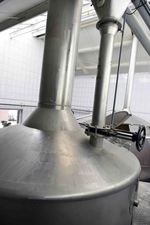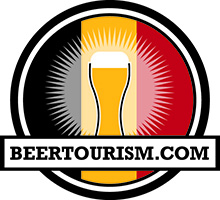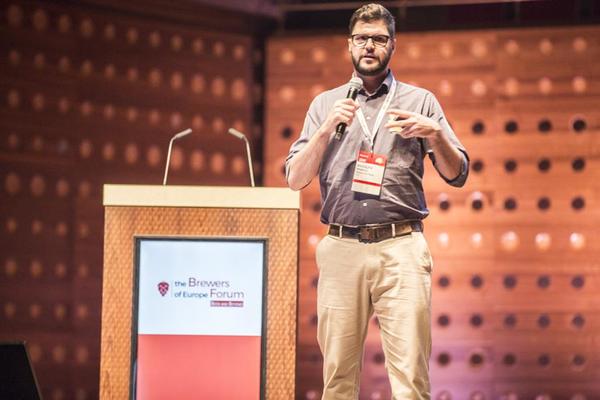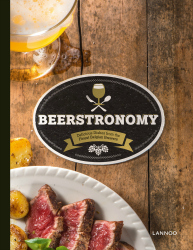Belgian
Beer

As its name suggests, Timmermans Lambicus Blanche is a cross between a lambic and a white beer. This refreshingly sour thirst quencher is reminiscent of the traditional farm beers brewed in the valley of the river Senne and the Pajottenland region to... [ more ]
Belgian
Brewery

Nowadays it's Bertrand Van der Haegen who's watching over the quality of the Silly beers. Not that his father, Jean-Paul, can't help but take a glimpse over Bertrand's shoulder now and again. After all, the brewery is ‘his ... [ more ]
Belgian
Food

We succumb every single time. Our affection for our national pride, 'frieten' or 'frites', goes as deep as our love for our beer, chocolate and waffles. Nothing tastes as good as a paper cone filled to the brim with golden-b... [ more ]
Belgium Travel Guide

Genk
Beer, travel and tourism guide for visitors to Genk in Limburg. Information about where to eat, drink beer and visit in and around Genk.[ more... ]

Bruges
Beer, travel and tourist Information about the historic Belgian city of Bruges (Brugge). Things to do, where to stay, eat and drink when visiting Bruges.[ more... ]

Bouillon
Beer, travel and tourism guide for the picturesque city of Bouillon in the Ardennes. Things to see, do, where to stay, eat and drink when visiting Bouillon.[ more... ]

Ypres
A beer, travel and tourist guide for visitors to the Belgian city of Ypres (Ieper). Information about where to eat, stay and visit in Ypres.[ more... ]

Durbuy
Beer, travel and tourism guide for the picturesque city of Durbuy in the Ardennes. Things to see, do, where to stay, eat and drink when visiting Durbuy.[ more... ]

Ostend
Travel and beer guide for the Belgian coastal city of Ostend (Oostende). Information about where to eat, drink, stay and things to do when visiting Ostend.[ more... ]

Sint-Truiden
Beer, travel and tourism guide for visitors to Sint-Truiden in Limburg. Information about where to eat, drink beer and visit in and around Sint-Truiden.[ more... ]

Ghent
A beer, travel and tourism guide for the Belgian city of Ghent (Gent). Where to stay, visit, eat and things to do when visiting Ghent.[ more... ]
_1024x569.jpg?1472673521)
Beer Tourism Prize Draw
By entering you confirm that you are of legal drinking age and agree to our terms and conditions.
| Latest winner/s: | Lindsey Davies |
Belgian Beer Guide
No, we really don’t want to come across as arrogant. That is simply not in our nature. We are a small country and we are well aware of our place in the world. But we do like to make an exception for beer.
 Barrel aging Belgian beer
Barrel aging Belgian beer
© BeerTourism.com
We have made our mark on the world beer chart and it has awarded us a rising star. How did all this happen?
Well, it is far from a coincidence. In Belgium we are brewing far more beer than we are consuming ourselves. Relatively speaking we are Europe’s largest beer exporter.
Every year, 18 million hectolitres of beer is flowing from the tanks of Belgian breweries and 11 million of this output flows across the border(s), to our neighbouring countries of France, the Netherlands, Germany and the UK as well as farther-flung destinations such as Italy, Spain, Scandinavia, the USA, Japan and China…
Belgian beer is at the pinnacle of quality craft beer and is now a top reference on a global level, attracting the same status as Scottish whisky or Italian wine.
So what makes ‘brewed in Belgium’ so special? Top of the charts has to be our respect for centuries-old tradition. We don’t mean to say that we are living in a dusty beer museum.
Far from it. Many brewers here are using brand-spanking new, gleaming stainless steel brewing kettles and have access to fermentation and maturation tanks that are forever increasing in size.
 Rochefort, a Belgian Trappist beer..
Rochefort, a Belgian Trappist beer..
© BeerTourism.com
In the brewery labs everything is analysed down to the minutest detail. This is how the brewers manage to produce beers of consistent quality. After all, this is what the average beer drinker looks for in their beer.
When he or she orders their usual pils, they will expect the same familiar taste in the glass every single time.
All this sounds far easier than it actually is. And the more accessible the beer, and the less alcohol it contains, the harder it is to produce the same brew time after time.
This is where science comes in to lend a helping hand, and increasingly so. Belgium is also home to many renowned experts: international experts when it comes to hops, fermentation etc. even down to the specialised field
.jpg?1372534907) Lambic Belgian beer at Mort Subite
Lambic Belgian beer at Mort Subite
© BeerTourism.com
of beer economics. These experts act as advisers to the brewers.
Just to provide an example: most established breweries are having clones of their yeast strains stored in the yeast banks managed by the universities.
The academicians act as advisors for the development of new beers and collaborate with the brewery to find the right strain of yeast.
In the meantime, they have developed a taste for test brewing themselves to the point where nowadays, albeit on a very modest scale, in their own microbrewery they try to resurrect beers that were thought to have vanished from the brewing world.
Family breweries with roots going back to the 19th century or even more ancient have managed to ensure the survival of traditional beer styles, as shown by the story of the Belgian Family Brewers. In addition to the omnipresent pils there is a wealth of other options.
There is lambic brewed in the artisan way, using spontaneous fermentation, which has matured on oak for a number of years before it is judged ready to be served; or to be re-incarnated as a re-fermented, sparkling, oude gueuze.
 Beer in Belgium
Beer in Belgium
© BeerTourism.com
The same procedure gives rise to the oude kriek, enriched with sour cherries this time around.
This style of beer is given plenty of time to develop its complex flavours, just like the new generation of top-fermented beers matured in recycled wine, whisky or cognac barrels.
The process allows the beers to absorb the rich aromas and tastes of the alcohol previously stores in these barrels.
One of the finest aspects of Belgian beer culture is that it allows you to re-trace the origin of various traditional beer styles through the ages.
This is not just another hype or marketing stunt. If the saison from Hainault is scoring highly at the moment, it only bears out the respect for the authentic farm ales, traditionally brewed in winter and ready to
 Belgian beer - Kriek
Belgian beer - Kriek
© BeerTourism.com
quench the thirst of the farmers and seasonal workers in the summer to come.
Abbey beers point out the historic importance of the monks, who were the educated people of their time. They advised people to drink beer instead of water as the quality of drinking water, especially in the cities, was way below par.
Two hundred years ago our ancestors used to consume over two hundred litres of, albeit ‘small’ (low alcohol), beer per capita per annum.
Nowadays we like to keep things civilised with a consumption of eighty litres per head, but the beer we enjoy these days is stronger and of a higher quality.
Leafing through this virtual beer guide you cannot help but be ‘sucked into’ the rich Belgian beer world.
You get a taste of the broad story of Belgian beer production or else you zoom in to explore the history of a well-known brewery and its beers. Beer Tourism went online in early 2013.
We have continued to grow and have expanded our content as well as our number of partners – the breweries featured on the site – and our coverage. The number of visitors to our site
 Brewing Belgian beer at De Struise Brouwers
Brewing Belgian beer at De Struise Brouwers
© BeerTourism.com
from all over the world is growing by the day.
In addition to our website we continue to showcase the rich Belgian beer culture in different ways through our posts on Google+, Facebook, Twitter, LinkedIn, Instagram and Pinterest.
You can use Beer Tourism as your window on the world of Belgian beer, freshly drawn from the source: the Belgian breweries.
For many years Belgian beers were only talked about outside our country’s borders.
We felt it was high time we turned things around and started wielding our own mashing stick. We do hope you enjoy what we have to offer.
We like to feature history and tradition and tell the story of the established breweries. However, we also like to focus on new and upcoming trends, microbreweries and local players who like to keep things small.
 Belgian beer and food pairing
Belgian beer and food pairing
© BeerTourism.com
They are also making a contribution to the surprisingly diverse Belgian beer culture. The microbrewers have turned out to be a blessing for the entire beer landscape thanks to their abundant creativity.
They shy away from what is traditional, are lightning-quick when it comes to picking up new trends and know how to translate these into our beer culture.
They ensure that, in addition to ‘balance in the glass’, there is room for what may appear at first sight to be far-fetched experiments.
And so, we are seeing niche beers co-existing happily with the mainstream. This creativity is now also fermenting and bubbling up into the Belgian food scene.
After all the brasseries, taverns and pub-cafés that have found their way towards a good beer.
The chefs of starred restaurants are now following in their footsteps and are using beer to cook with as well as in beer pairings. They are now discovering an endless playing field of taste and are exploring the wide spectrum of beers with an alcohol by volume of between 3% and 13%.
 All smiles... drinking Belgian beer at Gruut
All smiles... drinking Belgian beer at Gruut
© BeerTourism.com
Hobby cooks are also increasingly using beer in their kitchens. It’s all part of the trend towards ‘terroir’ where we see regional products gaining in popularity.
After all, you will find beers in every region that suit the local dishes particularly well…
Our enthusiasm for beer almost makes us forget that there are plenty of other riches to be discovered in our tiny country on the North Sea.
With our travel guide to Belgium we would like to introduce you to our well-known towns and cities; Brussels of course, but those in Flanders and Wallonia too, all of them rich in both history and (beer) culture.
Visit Bruges, Brussels, Ghent, Antwerp, Namur and Liège or discover the lesser-known cities of Kortrijk, Hasselt, Tongeren, Genk and Sint-Truiden. Some of our cities are almost synonymous with one single event in history.
 Freshly harvested hops
Freshly harvested hops
© BeerTourism.com
Just think of Ypres that is mentioned in the same breath as Flanders Fields and the First World War, or Bastogne in the Ardennes, which still bears the traces of the Battle of the Bulge that was fought in the Second World War.
The towns of Bouillon, La Roche and Houffalize take on the splendid colours of the forests of the Ardennes. Leuven, the birthplace of the world’s largest brewery, is laying claim to the title of beer capital. Poperinge is at the centre of Belgian hop cultivation.
Nieuwpoort and Ostend bring you the salty tang of the beaches of the North Sea. So many cities, so many stories in what is after all only a tiny country.
In Belgium you are never more than an hour’s drive away from entering another world where you will find a different culture and sometimes also a different language.
This kaleidoscope of flavours and styles translates into your glass of beer. The good news is that you are never far away from tasting something that will tingle your taste buds. Open up all your senses. Take your time. Enjoy the slight air of inebriation. And above all, do let us know how it all went down!
Cheers!
Erik Verdonck
Editor-in-Chief & Artistic Director at BeerTourism.com
You Might Like

The Duvel Moortgat Brewery caters to everyone’s tastes with 3 different brewery experiences. From complete novice to experienced beer lover, Duvel has the brewery visit package for you.

Kasteel Brouwerij Vanhonsebrouck, well known for it's "Kasteel" beer range, now offers their Bierkasteel beer experience; brewery visit, event location, restaurant, bar and shop.

Everything you ever wanted to know about (Belgian) beer under one roof. You get to feel, smell and taste ingredients and discover the typical Belgian beer styles. Come celebrate Belgian beer culture in heart of historic Bruges! Shop and bar are accessible without visiting the museum.

This freemium App for IOS and Android lets you explore and find the best that Belgium's UNESCO recognised beer culture has to offer. Find breweries, bars, restaurants, festivals, events, experiences and beer shops; create you own beer trips and be your own tour guide!

Brasserie Dubussion prides itself on tradition and taste and has opened a brand new visitors centre, the Beerstorium. Learn about the rich history, beers and brewing at the oldest brewery in Wallonia. You can visit this authentic Belgian brewery, see brewing in action, as well as taste some of their delicious brews for yourself, including their legendary Bush (Scaldis) beer range.
Beer Tourism Newsletter Signup
Enter your name and email address on the right and click "SignUp" to join.














